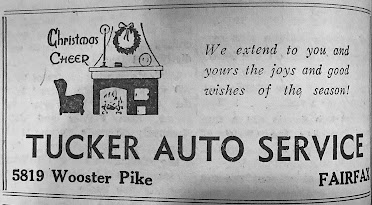It was a fixture from childhood until I was a young adult. I remember seeing the blue building atop the hill as we travelled west on Columbia Parkway to the Red Bank Road exit enroute to Swallen’s. In case there was any doubt what you were looking at, there was the sign - VELVA SHEEN.
Velva Sheen was founded in 1936 by Oscar Schroeder and
was originally a flag and banner manufacturer. In its early years, the plant
was located at various sites in Over the Rhine and the West End. In 1957,
Robert Rielly, a St. Xavier High School and Xavier University graduate and
veteran of World War II, purchased Velva Sheen. His brother, William, an
attorney, served as a consultant and later joined the company full time.
William was also a St. Xavier and Xavier University graduate and World War II
veteran and had graduated from the University of Cincinnati College of Law.
Neither brother had any background in the industry. The company’s annual sales
at the time of the acquisition were $500,000 and the company had 20 employees.
The 30-foot-long printing-flocking presses at Velva Sheen move continuously and are operated by a technician with complete control over the process from the first step, the imprint with colored adhesive, to heat treatment of the flocked image in an oven. The garment is first placed on the press under an illuminated image, the adhesive is then impressed through the silk screen and while the operator watches in a mirror, the garment is flocked, the waste flock is recovered by suction, and the garment moves through a 265-degree oven for drying.
They also had a number of customers from fraternal
organizations, camps, the U.S. government, and corporations.
By 1970, student unrest on U.S. college campuses impacted Velva Sheen’s business. After all, students who were challenging
their schools’ authorities, weren’t going to dish out money to advertise those
schools on their clothing.
In 1972, Velva Sheen was acquired by Beatrice Foods. It
operated as a division of Beatrice and Velva Sheen management was kept in place
with the Rielly brothers remaining in charge.
The Velva Sheen misprint store on Wooster Pike was only
open for around five years, but its closure wasn’t the end to their outlet
stores. In August 1978, the Hyde Park outlet store opened and the company
ultimately had seven retail locations. They supplemented the misprints and
overruns with other sportswear, jackets, shoes, and athletic accessories and
began offering screen printing on orders as small as 10 items.
Bill Rielly once confronted an ice cream vendor who sold
ice cream cones to his employees that, he said, were half air and half ice
cream. When the ice cream man told him no one else had complained, Rielly
bought an ice cream machine. Employees had ice cream once every week and on
days when the temperature exceeded 90 degrees. He often bought lunch for employees
who had to work on Saturdays. He held a contest for employees to guess when the
company would print its 200 millionth item with the winner receiving a trip to
Walt Disney World. Bill Rielly retired sometime after 1987.
In November 1994, Houston-based Brazos Sportswear, Inc.
purchased Velva Sheen with plans to merge it with their licensed sportswear
division. The company's headquarters moved to Fairfax. In 1996, the company closed
its retail locations to focus on the wholesale business. Within the next year,
Brazos acquired more apparel companies, including Cincinnati-based CS Crable
Sportswear. In December 1997, Brazos announced that it would close the Fairfax
plant and move its headquarters to the CS Crable location in Clermont County.
The closure was related to company restructuring to reduce excess capacity due
to the recent acquisitions. 129 people worked at the Fairfax plant, 80 of whom
lost their jobs.
































